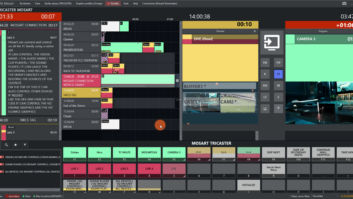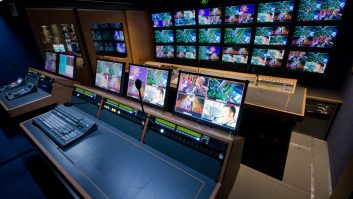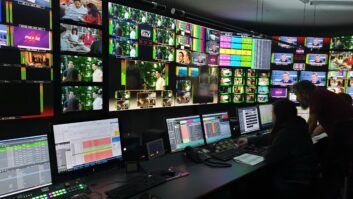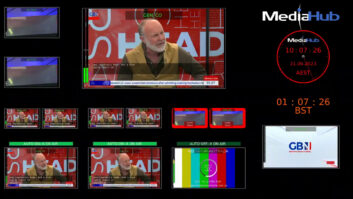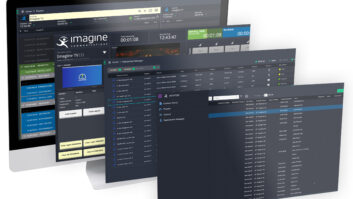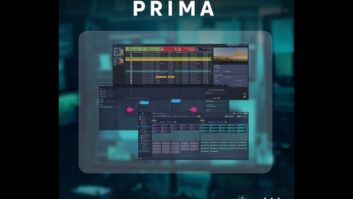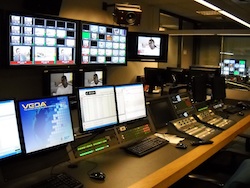
Technology has changed so rapidly that ten years is a long time in playout automation. This vital equipment has evolved from multiple VTRs controlled by computer to carousels linked to scheduling software to servers running powerful management programs. How did RTBF evolve its playout? Kevin Hilton reports.
Technology rate of change has been so fast that even an IT-based system installed a decade ago is going to look outmoded — after all, 1TB was considered a lot of storage capacity five or so years ago and broadcasters paid a premium for it. Now anyone with €50 to spare can put a 1TB hard drive in a desktop PC. For TV stations storage is no longer the sole consideration; many need to play out more channels than before and automatically control the distribution and media asset management functions from a single database.
These were the new requirements that technical teams at Belgian broadcaster RTBF (Radio Télévision Belge de la Communaté Française) had to meet when the decision was taken to replace its control room automation system. A Harris ADC100 was installed at RTBF’s Reyers broadcast centre in Brussels in 1999 but since that time its operations have grown.
Broadcasting to Belgium’s French-speaking community, which is largely concentrated in the south of the country, RTBF, is a public TV and radio broadcaster, sharing Reyers with VRT, its counterpart serving the Flemish-speaking population in the north of Belgium. RTBF currently transmits four TV channels — La Une, La Deux, La Trois and Arte Belgique — but with the move to HD more capacity and flexibility were needed in its playout department. Patrick Moulin, project manager at RTBF, comments that although the Harris system was robust it could play-out only three channels and had a basic ingest facility.
“The ADC 100 didn’t allow us to evolve easily towards a play-out of eight channels running in an entirely secure way, with main transmissions and back-ups,” says Moulin. “What we had in our control room no longer responded to our needs in terms of scalability and reliability. What we needed was something that would be flexible enough to adapt to our specific needs and be able to grow with them.”
Open Exchange
By 2008 RTBF realised that its playout arrangements were outdated, which led to a Europe-wide tender process. Engineers evaluated three systems before selecting the SGT VEDA, which was launched at the NAB Convention in 2009. “It was a slightly risky bet as the product wasn’t fully completed at the time in terms of the user interface but today we do not regret our decision,” Moulin comments.
SGT built its business and reputation in its native France during the 1990s, working with TF1 and Canal+. Celebrating 20 years of producing broadcast software this year, SGT now reports that over 60% of its sales are outside France, with clients including VRT, Be TV and Mostra Communications in Belgium, regional German broadcaster SWR, the RTL group, ProfMedia and RTK in Russia, the Dutch SBS and Nova in the Czech Republic, as well as France Télévisions and M6 back home.
VEDA is now SGT’s main automation, playout and asset management product, with new components expanding the range on a regular basis. A key element of VEDA is the open BXF (Broadcast Exchange Format), which allows general communication between different devices, with full exchange of data.
Richard de Jong, SGT’s area director for Europe, the Middle East and Africa, points out the “big change in broadcasting”, from the serial interfaces of the past to today’s IP networks. “This gives better scalability, for the systems to be built up as customers’ needs grow,” he says. “RTBF wanted secure playout, with full redundancy, and integrated asset management. And as a small company we can adapt our product to specific needs.”
SGT has had a presence in Belgium for 15 years, originally dealing directly with its customers there. Now it works through Brussels-based Video Promotion (VP), which is its preferred systems integrator in the country. VP operates in Luxembourg and France, as well as Belgium, and in addition to its installation work distributes products and provides maintenance, repair and general services to broadcasters and facilities.
VP project manager Antony Olivier says the brief from RTBF was to move to tapeless operation, with capacity for playing out eight channels, including HD services. The eight are made up of three premium channels and five thematic services but, says Olivier, a 16-channel infrastructure had to be built because RTBF wanted full back-up and redundancy for each service.
RTBF’s new automation and control system went on air in September 2009 and features five key elements from the VEDA range: media management, running live broadcasts such as news as well as general programme play-out, both with material coming from either manually controlled VTs or automated Flexicarts; control of the aspect ratio converter, with information from the scheduling database identifying video files so they are broadcast in the correct picture format; a media locator feature for finding files; a device controller, connected over either RS422, GPI (WSS) or the facility’s main Omneon network server; a loading tool for managing file transfer, which runs two Omneon servers, the DIVA archive and an Isilon server; the central database, which is common to both automation and media management functions; and the traffic interface, which links through the BXF protocol to the MediaGenix What’s On scheduler.
The move to the VEDA-based system, including staff training, took 18 months, although installation and configuration accounted for only a small proportion of that time. Moulin says switchover was complex, with operators changing working methods to suit the new technology. He adds, however, that the effort has already paid off in terms of greater performance and reliability for the play-out operation. “VEDA fits our workflow,” he says, “particularly with automated quality checking of material using Interra Baton, the ARC management and the API on the Omneon server.”
A flexible system means that it rarely stays the same for long and Patrick Moulin is now looking at the next phase of expansion, automating file transfers to RTBF’s video-on-demand clusters.
